Draft N Router Coverage: When the "n" in 802.11n really means "not yet"
by Gary Key on August 30, 2006 5:00 AM EST- Posted in
- Networking
Unencrypted Throughput - Client to Server
Our throughput test compares the performance of our three Draft N routers against the NETGEAR RangeMax 240 router based upon the Pre-N MIMO technology. This router features the proprietary third generation Airgo chipset and to date this technology has held the lead in wireless throughput and distance. In an interesting turn of events Belkin has chosen not to support 802.11n or 802.11g only transmission modes. We had to test the Belkin N1router with the wireless option set to mixed n/g/b mode. In the test results we are reporting today there are not any 802.11b or 802.11g compliant devices active so the scores should be comparable. In our next series of articles we will look at true mixed mode results along with compatibility between our 802.11n Draft 1.0 devices and other wireless standards.
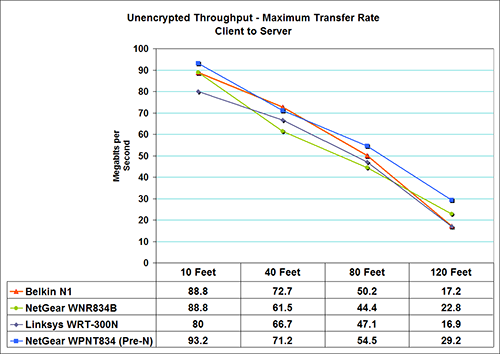
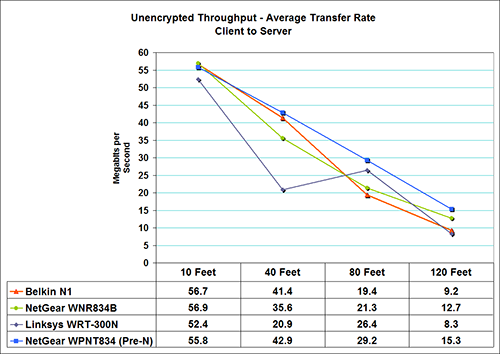
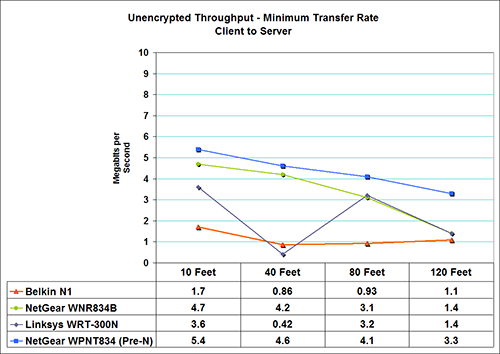
The NETGEAR WPNT834 Pre-N router has the highest throughput overall and shows a very consistent throughput pattern up to 120 feet. The Belkin N1 excels at the 40 and 80 foot levels in maximum throughput compared to our other Draft N routers but its average throughput drops off sharply at the 80 foot range. The NETGEAR WNR834B provides the most consistent throughput across the full test spectrum of the Draft N routers.
In fact, both NETGEAR offerings provided more consistent results, while the transfer rates for the Linksys and Belkin offerings showed a lot more variability. The Belkin provides good average throughput, but the minimums are consistently lower than the other offerings, making it less useful for tasks that demand a consistent connection (i.e. video streaming). The Linksys also showed consistently worse performance at the 40 foot test location than at 80 feet, a result that was unexpected but typical of our testing experiences with the various Draft N equipment.
Encrypted Throughput (WPA2-PSK) - Client to Server
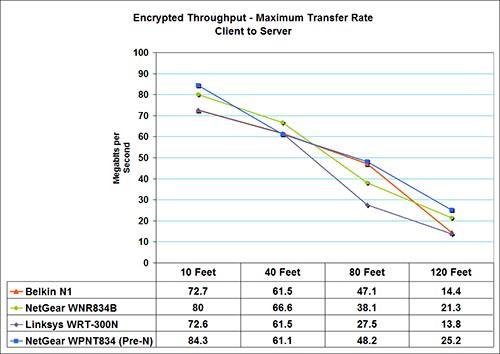
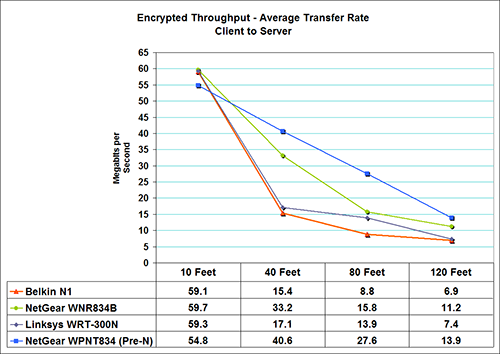
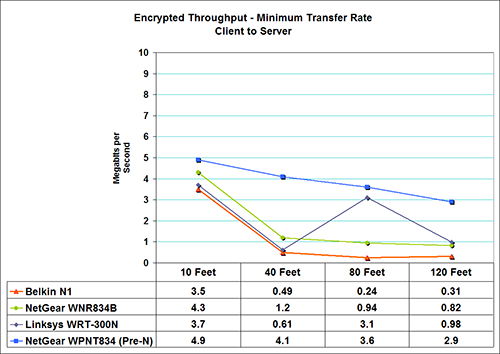
We spent an inordinate amount of time testing our routers and clients with WPA2-PSK security enabled as the test results were not always consistent or complete. After the final firmware and driver updates we were able to consistently achieve the results shown. However, at first glance you will notice that our encrypted results in the average throughput test are higher than the unencrypted results at 10 feet. We ran our tests several different times over the course of the last two weeks with the same results. We already know that 802.11n Draft 1.0 specifies WPA2 security protocol as the preferred method of encrypted transmission and it appears the hardware is optimized for it at close distances.
While the 10 foot distance shows very little loss and actually gains for most of the routers we see an issue with the Belkin N1 suffering an 18% loss with encryption enabled in the maximum throughput results. Even worse is the performance loss of the Belkin router in average throughput at 40 feet and beyond once encryption is enabled. On our 40 foot test we see the Belkin N1 suffering a 62% performance hit in the average throughput numbers and 54% at 80 feet. Our Linksys router also has performance issues with WPA2-PSK enabled at the 80 foot range. Our two NETGEAR routers offer the best results with the Pre-N version once again coming out on top.
Our throughput test compares the performance of our three Draft N routers against the NETGEAR RangeMax 240 router based upon the Pre-N MIMO technology. This router features the proprietary third generation Airgo chipset and to date this technology has held the lead in wireless throughput and distance. In an interesting turn of events Belkin has chosen not to support 802.11n or 802.11g only transmission modes. We had to test the Belkin N1router with the wireless option set to mixed n/g/b mode. In the test results we are reporting today there are not any 802.11b or 802.11g compliant devices active so the scores should be comparable. In our next series of articles we will look at true mixed mode results along with compatibility between our 802.11n Draft 1.0 devices and other wireless standards.



The NETGEAR WPNT834 Pre-N router has the highest throughput overall and shows a very consistent throughput pattern up to 120 feet. The Belkin N1 excels at the 40 and 80 foot levels in maximum throughput compared to our other Draft N routers but its average throughput drops off sharply at the 80 foot range. The NETGEAR WNR834B provides the most consistent throughput across the full test spectrum of the Draft N routers.
In fact, both NETGEAR offerings provided more consistent results, while the transfer rates for the Linksys and Belkin offerings showed a lot more variability. The Belkin provides good average throughput, but the minimums are consistently lower than the other offerings, making it less useful for tasks that demand a consistent connection (i.e. video streaming). The Linksys also showed consistently worse performance at the 40 foot test location than at 80 feet, a result that was unexpected but typical of our testing experiences with the various Draft N equipment.
Encrypted Throughput (WPA2-PSK) - Client to Server



We spent an inordinate amount of time testing our routers and clients with WPA2-PSK security enabled as the test results were not always consistent or complete. After the final firmware and driver updates we were able to consistently achieve the results shown. However, at first glance you will notice that our encrypted results in the average throughput test are higher than the unencrypted results at 10 feet. We ran our tests several different times over the course of the last two weeks with the same results. We already know that 802.11n Draft 1.0 specifies WPA2 security protocol as the preferred method of encrypted transmission and it appears the hardware is optimized for it at close distances.
| Unencrypted versus Encrypted Throughput - Maximum Mbps Percentage Difference - Client to Server |
||||
| 10 Feet | 40 Feet | 80 Feet | 120 Feet | |
| Belkin N1 | -18.13% | -15.41% | -6.18% | -16.28% |
| NetGear WNR834B | -9.91% | 8.29% | -14.19% | -6.58% |
| Linksys WRT-300N | -9.25% | -7.80% | -41.61% | -18.34% |
| NetGear WPNT834 (Pre-N) | -9.55% | -14.19% | -11.56% | -13.70% |
| Unencrypted versus Encrypted Throughput - Average Mbps Percentage Difference - Client to Server |
||||
| 10 Feet | 40 Feet | 80 Feet | 120 Feet | |
| Belkin N1 | 4.23% | -62.80% | -54.64% | -25.00% |
| NetGear WNR834B | 4.92% | -6.74% | -25.82% | -11.81% |
| Linksys WRT-300N | 13.17% | -18.18% | -47.35% | -10.84% |
| NetGear WPNT834 (Pre-N) | -1.79% | -5.36% | -5.48% | -9.15% |
While the 10 foot distance shows very little loss and actually gains for most of the routers we see an issue with the Belkin N1 suffering an 18% loss with encryption enabled in the maximum throughput results. Even worse is the performance loss of the Belkin router in average throughput at 40 feet and beyond once encryption is enabled. On our 40 foot test we see the Belkin N1 suffering a 62% performance hit in the average throughput numbers and 54% at 80 feet. Our Linksys router also has performance issues with WPA2-PSK enabled at the 80 foot range. Our two NETGEAR routers offer the best results with the Pre-N version once again coming out on top.










22 Comments
View All Comments
shoRunner - Wednesday, August 30, 2006 - link
As hinted at in the article the overall reliability of these draft-n routers is terrible. Having setup 60+ wireless networks in the past few months using many different kinds of routers including these draft-n routers, they have performed very badly some models requiring daily powercycling and constant firmware updates. If you are looking for a reliable fast wireless network the netgear 240 pre-n router is definately the better buy.Myrandex - Wednesday, August 30, 2006 - link
The Dlink DGL-1000 router has gigabit ethernet and is freaking amazing. Not to mention I enjoy the blue LEDs on the frong, and performance is nice.Jason
blckgrffn - Wednesday, August 30, 2006 - link
If were are going to sustain 300 megabit throughput on our wireless devices, why isn't the wired backend gigabit?Seriously, early adopters of this stuff are also likely to have gigabit networking equipment, as that has been shipping in volume for the at least the last three years or so, and really became affordable as far as switches go last year. My $30 D-link gigabit switch has been working just fine...
Nat
bobsmith1492 - Wednesday, August 30, 2006 - link
On page 2, the feature chart states the three routers have 2.4 GHz bandwidth... I believe that is actually their operating frequency.erwos - Wednesday, August 30, 2006 - link
The spectrum nuking issue is a real concern to me. I live in an apartment building, so I'm already getting crowded by random wireless phones and microwaves all around me. I _shudder_ to think what will happen when some of these "draft 802.11n" devices become more common. I wish I could claim this kind of callousness was because of 802.11n, but I know it's not true - the original channel bonding schemes for 802.11b/g were infamous for this kind of thing.I'm trying my best to be a good citizen and turn that sort of stuff off, but I fear I may to have move to 802.11a, and the less-troubled 5ghz band, soon.
-Erwos
DigitalFreak - Wednesday, August 30, 2006 - link
I moved to 802.11a a long time ago, after more and more b/g APs started showing up. Been running great every since.I really have to wonder why the IEEE didn't use the 5ghz frequency for 11n. I know 11a has a shorter range than 11b/g, but I would think it would be easier to overcome that problem than it is to get past the major spectrum issues in the 2.4Ghz range.
yyrkoon - Wednesday, August 30, 2006 - link
Well, atleast not here in the US I mean.yyrkoon - Wednesday, August 30, 2006 - link
2.4GHZ isnt regulated, 5.8GHZ may be, I'm not sure.Lonyo - Wednesday, August 30, 2006 - link
802.11n might be useful in the home eventually as broadband gets faster (30mbps+ connections), but for real high speed networking, it seems wired is still the only option.Can't say it's so suprising, but at least wireless is getting more useful in terms of matching increasing broadband speeds (although with existing MIMO, .11n isn't quite so useful yet, until it can exceed MIMO).
LoneWolf15 - Wednesday, August 30, 2006 - link
Are you kidding? There are far more reasons for high-speed wireless in the home than just broadband. Streaming media servers (having all my movies, music, etc. on a server that can be streamed to an HTPC or appliance) are a prime example of a good use of high-speed WiFi, especially for those of us that don't wish to deal with rewiring CAT-5 in our houses.As for .11n, it isn't useful yet because there isn't a standard, and yet vendors are trying to capitalize on a need by releasing hastily-designed pre-standard product. It's not robust, and it requires proprietary hardware. When the IEEE finally figures this out (IMO, it should have been some time ago, they've had enough time, though dealing with bickering vendors is an issue) and issues a true standard, things should work out better, much like when V.90 finally was ratified.